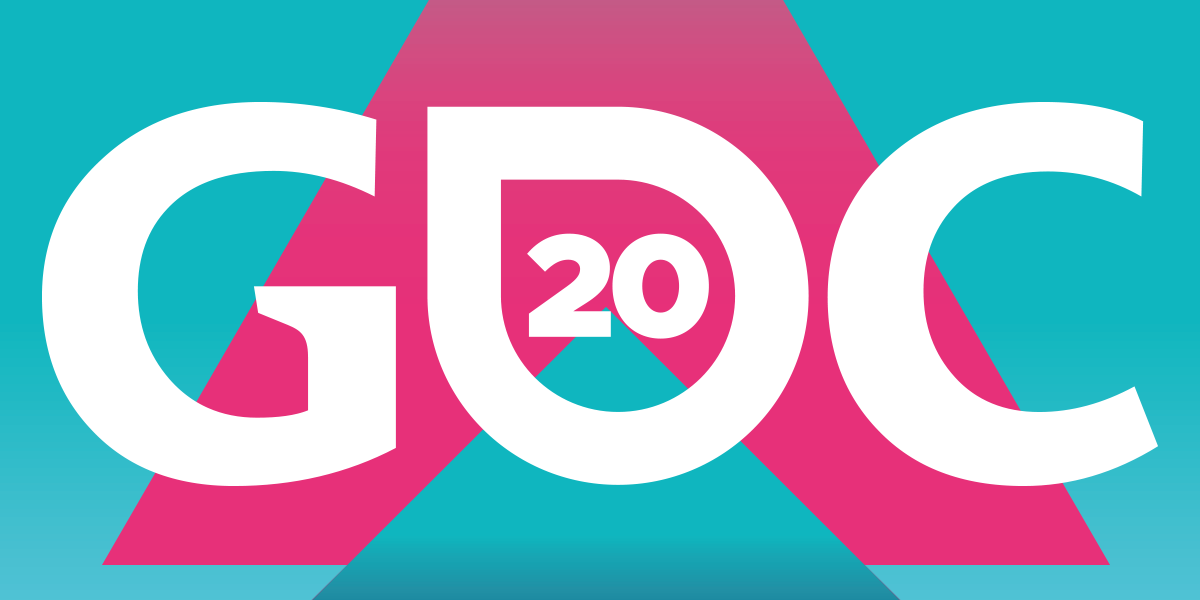
Hey it was GDC 2020 Summer edition last week. I got a free pass because I gave these two talks during the GDC March edition. I managed to watch 3 marketing talks that I thought you would find interesting and wrote up my notes.
A Step-by-Step Guide to Building Steam Wishlists
Speaker: Mike Rose
TL;DR of the talk
- Basically do anything in your power to get your wishlists up to 12,000 before launch because that is the minimum threshold to get on the “popular and upcoming list” because while on that list you can earn anywhere from 1000-3000 wishlists per day.
- To figure out your week 1 sales, take the number of wishlists just before the sale and multiply it by 20-30%.
- Do whatever it takes to get that first 12,000 such as giving your game away as a “beta”
- Reddit ads are worth the money
- Youtube is better than Twitch
- Don’t soft launch your Steam Page
The talk centered around wishlists and why we care so much about them. Here is why they are so important:
- They are a good way to track how your marketing is working.
- Wishlists represent a potential sale and you can anticipate how your game will sell
- People who wishlist are emailed when the game goes on sale post-launch so they convert.
- The current estimate of your week 1 sales are that 20% of your pre-wishlist count will turn into sales. It isn’t that 20% of wishlisters convert, its just the conversation rate + people who discover your game will convert on that first week. Sometimes you can get 100%+ wishlist conversion rate because when it went live thats how many people bought it.
Don’t push for preorders at launch because the way steam calculates the top seller’s list. Any pre-orders for your games do not count towards your sales rank. Steam basically tells you not to do preorders unless you are a AAA studio. Yes I saw Fall Guys do preorders but you are not them.
Basically Mike’s whole strategy centers around getting onto the “Popular and Upcoming” list. In his experience, that list gets him 1000-3000 wishlists per day. If you spend a couple of days on there you can get thousands of wishlists. For example their game “Yes Your Grace” earned half of its wishlists by appearing on that list in the run-up to release.
Mike recommends against just throwing up a Steam page and then slowly marketing it. Instead, they build a huge event around the steam page launch. They do a beta demo for YouTubers, do press outreach, everything they can to boost initial wishlists. This initial burst “teaches” the Steam algorithm that your game is awesome and not some garbage asset flip crap. Also, have your steam page translated when your game goes live. Even if the game is not fully translated. No More Robots translates into Chinese and German then maybe French and Spanish. There should be no barrier to people wishlisting, you want as many as possible.
Also, don’t put your Steam page up too far in advance. The people who initially wishlisted it start to lose interest in your game and are less likely to buy it. Look at this chart he showed about wishlist age. Not that very old wishlists don’t typically buy.
Mike then gave a rundown of how to get wishlists
- 4-5 months out – Have a beta build – it is really a demo not a beta and you give it to streamers.
- When you have the beta signup form, also have a link out to the Steam page and ask people to wishlist it.
- Note that a huge number of the people who get your game as a demo are not going to buy it. They are just there for the free demo. They still help if they wishlist it though because you are trying to get that total number up to 12,000. Your goal is to get on that Upcoming list, not to sell to those freeloaders. You are also just trying to teach the algorithm.
Youtubers help drive wishlists too. But not Twitch streamers. He has had his games streamed on Twitch to 25,000 viewers but that translated into 0 wishlists. The reason is that the Twitch community is mostly into just watching the streamers. There are also no links on Twitch to your game’s store page either. Instead, the youtube audience is much more likely to click over to your Steam page. They have received up to 2000-3000 wishlists from a single stream on Youtube. His recommendation is to build YouTuber lists and just slowly reach out to them. It is long and laborious.
Steam Tags are very important. They help your game appear in the “more like this” list. So just look at games most similar to yours and make the tags just like that target game. Also, avoid that Indie tag because it does nothing for you.
Reddit is helpful if done right. Don’t just pitch your game on there. Instead, turn it into a conversation. Every subreddit has slightly different rules so learn them. You have to leave comments and make your account active so that you don’t get flagged for self-promotion. Picking very specific subreddits like pixel art was helpful. They got 100s of wishlists from that.
Reddit Ads were actually worth it. By only paying by the click it is actually very valuable. It is much more cost-effective than going to physical shows. So don’t spend money on them. But you knew that from me anyway.
For making your store page look good really focus on the key art. They are always testing new Capsule art. Aim for 15% clickthrough rate and 10% on wishlist rate. Doubled the number of wishlists because they were on the popular upcoming.

The following chart was very interesting because it showed what actually moved the needle. Notice that the press is never on that list. It just doesn’t move any number.
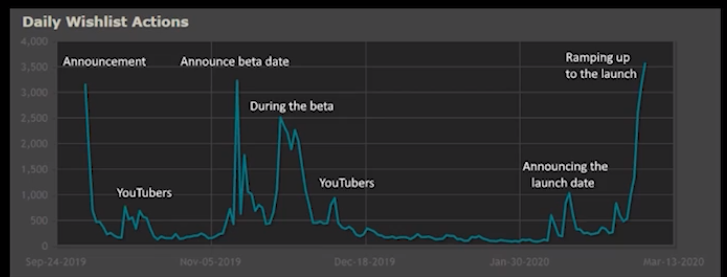
Bonus round chat section
There were a number of comments in this talk that were really great
- Someone asked Mike what subreddits he posts to. Mike said “I pretty much just try them all! Usually, I make sure they have at least 10k subs, but otherwise, I just go go go and try to get as many successful threads going as possible. A little bit throw mud at the wall until it sticks, quite frankly”
- A Native Chinese speaker in the chat said “If you’re doing Simplified Chinese, you might as well also do Traditional Chinese. It’s the same exact thing! It’s really just spelling differences, “grey” vs “gray” for example. You can literally just Google Translate it from Simplified and retain 100% of the context. It blows my mind how people don’t know that” – I have no idea if this is true. Can someone tell me?
David & Goliath: How a Newbie Solo Developer Landed on Xbox Game Pass
Speaker: Davionne Gooden
Creative Director Studio Zevere
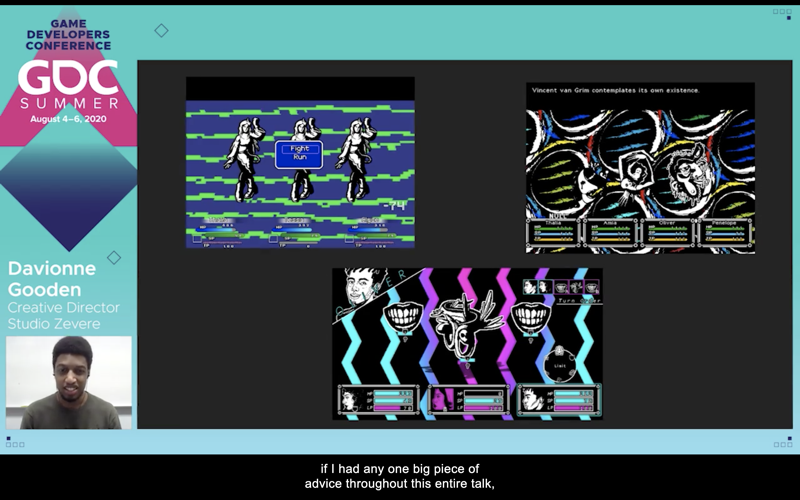
In every GDC there is always a heartfelt talk from a solo-dev who beat the odds to find some success. Past examples are here and then there is this one. Davionne’s talk fits into this genre of talk really well. The creator of “She Dreams Elsewhere” which was recently funded through XBOX games. It was a really good talk. BTW, I first found She Dreams Elsewhere when I was analyzing the top games in the Steam Summer Festival because it had an incredibly high wishlist conversion rate. Read more here.
Here are the tips TLDR
- Don’t make generic looking games
- But, your first game or the first attempt will not be impressive and won’t change the world.
- Keep posting on social media to slowly build an audience. You don’t have to “go viral” to make it worth it.
- Rely on micro-networks to build your early community. For him he leveraged the community of his game making tool of choice: RPG Maker
- Keep networking, and build on your previous relationships. FOLLOW UP and reach out to those contacts you did make.
- Important people may be following you and your journey and you do not know it.
- Say yes to opportunities even if you are not sure
Basically Davionne is a single-dev who makes games in RPG maker. He started with a game that was a pretty generic pixelart rpg but found a vibrant art style that attracted attention and got him a deal with XBOX Games Pass. That Games Pass earnings have more than paid for his game’s development. Here were the big takeaways of how he did this:
Davionne is based in Cleveland and has a background in Film, photography, art, screenwriting.
He made his first game in high school and waaaay over scoped how epic it would be. He put his first game up on Steam Greenlight. But it didn’t get an immediate pickup. It was the first time he got public feedback. The problem was it didn’t have a unique personality. His game was just generic pixelart style. His eventual aesthetic came about accidentally when he was just tinkering
In his words: “If you want attention, it has to deserve attention.” His previous version looked like a “generic rpg maker game.” He also added the great tip to “stay hydrated.”
He started posting on social media and never had a viral post. He slowly built up his following. The RPG Maker community was the source of his earliest fan base and they gave him some of his first feedback.
Davionne created the Steam Page for “She Dreams Elsewhere” early and that was important for building his community and attention. He recommended putting your game up there early. He networked within his Cleveland Gamedev community and that lead to his first convention. Cost of his first showing was about $300 for the booth. It was that cheap because those game devs shared booth costs.
Eventually, organizers at Dreamhack Atlanta found him and invited him to show his game there (This show was $600.) It is normally very esports focused but here was his indie game. He won best art house game at that show. His point: “You don’t know who is watching you from afar.”
At GDC 2019 She Dreams Elsewhere was featured in the Indie Megabooth. Indie Megabooth subsidized most of the costs for him to attend the show. Because of that show he met the XBOX indie team there and talked to them about Game’s Pass. This was a key moment for him. Here are some points he had about networking and using it to your advantage:
- You are always networking like how you present yourself and the word gets around who you are for good and bad.
- If you don’t know what to say to someone, ask them about their favorite games and what they do.
- Follow up if you get their card you never know when it will be the right time.
After GDC 2019 he ran into Microsoft again at the game devs of color expo. After that second meeting, Microsoft invited him to the ID@XBOX pre-event at PAX. That was the key moment. Eventually, he signed his deal with Microsoft for Gamepass. It was a short contract process and really easy to work with him.
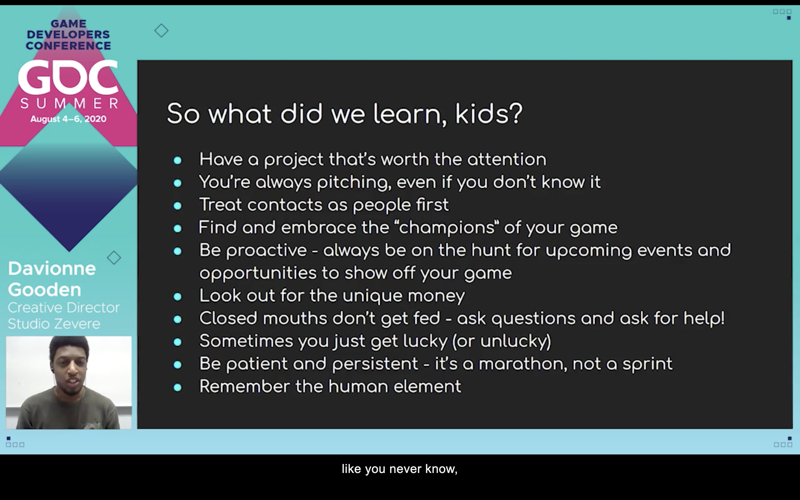
He didn’t reveal final numbers but the game pass deal was bigger than anything he had earned before. He made them read the final figure twice to him just to be sure he was hearing them correctly. He got what he wanted without a publisher.
What I like about Davionne’s story is that there was not one serendipitous moment. It was always a slow constant hustle to make his game, get the work seen, and into the meetings with the right folks.
Pre-Marketing Marketing: A Guide to Games Market and Competitor Research
Speaker: Victoria Tran (Communications Director, Kitfox Games)
Speaker: Dana Trebella (Founder Spoke & Wheel Strategy)
This talk was filled with the stuff I love to write about such as analyzing your market before you actually start making your game. Really great pair of speakers too.
When you do Market Analysis you want to look at what conditions are impacting it:
- Viability – Platform, Genre Saturation, Audience Size
- Marketing – Game differentiation, Messaging Angles, Competitors
- Insights – player sentiments, pricing, gameplay length (how long)
When Kitfox determines if a genre is viable they look at the following
- Multiple recent games in that genre
- Each of those games earns enough to recoup the intended budget
- The games have production value expectations that they as a studio can match
Kitfox then does a deeper competitor analysis once they see it is viable.
- They look for multiple games that are successful in the past year. This shows that fans are buying more than 1 game in that genre. For example farming simulators, do they only buy Stardew Valley or do they try others in the genre?
- They look to see where and how did people talk about that game?
- They also don’t just find similar games based on tags, but they also look at games with similar settings and keywords.
Build a spreadsheet that looks like this
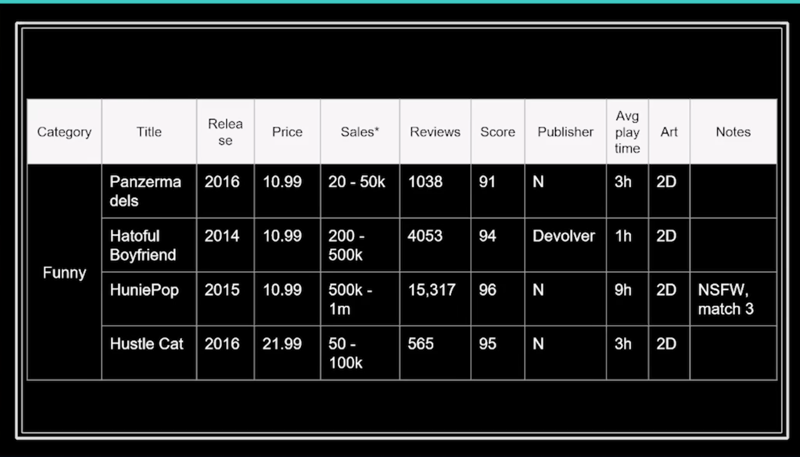
Quote of the talk on genre research: “Most of the dating sims seemed to be oriented toward a different giant boob demographic”
When the Kitfox crew was designing Boyfriend Dungeon they found that they actually had to make 2 high-quality games: A really good visual novel and a high-quality dungeon crawler. When they did dungeon crawler research they discovered that there is a really high bar of quality there that they knew they had to match.
The second half o the talk was all about how to perform a SWOT Analysis which helps guide how you talk about your game when marketing it. SWOT is a form of analysis that comes from the big corporate non-gaming-world of marketing. It stands for
- Strengths – what does your game do best? What can they only get from your game?
- Weaknesses – what do your competitors do better than you?
- Opportunities – where are the opportunities in the market, underserved, media coverage opportunities, streames?
- Threats – algorithm changes, changing tastes (longer development time), lack of resources, something already exists?
Dana reviewed an example from a game she marketed: Old Man’s Journey
- Strength – art style, and unique controls
- Weaknesses – old man main character and people hate the old, premium price tag, no replay, mobile works best
- Opportunities – the mechanics, no text so you can reach anyone around the world,
- Threats – app store homepage change looming, tablets and phone as a primary platform, a similar game in the same launch window
You can turn the analysis into your elevator pitch for your game
Here are some example of mistakes people make when trying to research their competitors in the SWOT analysis.
- Only looking at successes. You must look at the failures too. See if enough games fail in the same genre maybe move on
- If you think your game is soooo unique that SWOT doesn’t apply to you because you don’t have any competitors. That doesn’t happen.
- Short-sightedness – if you only look at the market now if your game dev is long
- Doing research too late, you have already built things